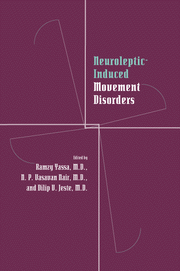Book contents
- Frontmatter
- Contents
- Contributors
- Preface
- Part I Historical perspective
- Part II Clinical aspects of tardive dyskinesia
- Part III Mechanisms underlying tardive dyskinesia
- Part IV Measurement of tardive dyskinesia
- Part V Tardive dyskinesia in different populations
- 19 Cultural aspects of tardive dyskinesia in Asia
- 20 Tardive dyskinesia in North America and the Middle East
- 21 Tardive dyskinesia in Europe
- 22 Role of ethnicity in the development of tardive dyskinesia
- 23 Tardive dyskinesia in children and adolescents
- Part VI Other neuroleptic-induced movement disorders
- Part VII Treatment of tardive dyskinesia
- Index
22 - Role of ethnicity in the development of tardive dyskinesia
from Part V - Tardive dyskinesia in different populations
Published online by Cambridge University Press: 09 October 2009
- Frontmatter
- Contents
- Contributors
- Preface
- Part I Historical perspective
- Part II Clinical aspects of tardive dyskinesia
- Part III Mechanisms underlying tardive dyskinesia
- Part IV Measurement of tardive dyskinesia
- Part V Tardive dyskinesia in different populations
- 19 Cultural aspects of tardive dyskinesia in Asia
- 20 Tardive dyskinesia in North America and the Middle East
- 21 Tardive dyskinesia in Europe
- 22 Role of ethnicity in the development of tardive dyskinesia
- 23 Tardive dyskinesia in children and adolescents
- Part VI Other neuroleptic-induced movement disorders
- Part VII Treatment of tardive dyskinesia
- Index
Summary
Since the first published report of tardive dyskinesia (Schonecker, 1957), numerous investigators have contributed to our understanding of the epidemiology and risk factors associated with this condition. In terms of numbers, such reports have noted that tardive dyskinesia is present at any given time in approximately 24% of patients treated with neuroleptics (Jeste & Caligiuri, 1993). As for risk factors, investigators have repeatedly associated older age with increased risk for tardive dyskinesia. Other reported factors, although less consistently associated with increased risk for tardive dyskinesia, include female gender, a psychiatric diagnosis involving affective features, early extrapyramidal symptoms, organic brain damage, and higher dosages and longer durations of neuroleptic treatment (Kane et al., 1992). Although considerable progress has been made in recent years through studies that have provided better estimates of the incidence of tardive dyskinesia and more meaningful data concerning the risk factors for tardive dyskinesia, relatively few have focused on the role of ethnicity as a risk factor (Pi, Gutierrez, & Gray, 1993).
In this chapter, we briefly review the relationship between ethnicity and tardive dyskinesia and present findings from our own study. We look at ethnicity vis-à-vis the presence of tardive dyskinesia, diagnosis of psychosis, neuroleptic dosage, and pharmacogenetics; we examine ethnic differences in terms of pharmacokinetics and pharmacodynamics; we look at a prospective study of the incidence of neuroleptic-induced tardive dyskinesia; and, finally, we offer suggestions for future research.
- Type
- Chapter
- Information
- Neuroleptic-induced Movement DisordersA Comprehensive Survey, pp. 298 - 310Publisher: Cambridge University PressPrint publication year: 1996

